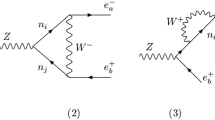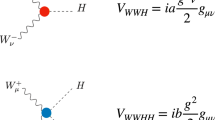Abstract
We propose a model for the vector-like lepton to explain the small muon mass by a seesaw mechanism, based on lepton-specific two Higgs doublet models with a local \(U(1)'\) symmetry. There is no bare muon mass for a nonzero \(U(1)'\) charge of the leptophilic Higgs doublet, so the physical muon mass is generated due to the mixing between the vector-like lepton and the muon after the leptophilic Higgs doublet and the dark Higgs get VEVs. In this scenario, the non-decoupling effects of the vector-like lepton give rise to leading contributions to the muon \(g-2\), thanks to the light \(Z'\) and the light dark Higgs boson. We discuss various constraints on the model from lepton flavor violation, electroweak precision and Higgs data, as well as collider searches.




Similar content being viewed by others
References
B. Abi et al., Muon g-2. Phys. Rev. Lett. 126(14), 141801 (2021). https://doi.org/10.1103/PhysRevLett.126.141801. arXiv:2104.03281 [hep-ex]
G.W. Bennett et al., Muon g-2 Collaboration. Phys. Rev. D (2006). https://doi.org/10.1103/PhysRevD.73.072003 ([hep-ex/0602035])
T. Aoyama, N. Asmussen, M. Benayoun, J. Bijnens, T. Blum, M. Bruno, I. Caprini, C.M. Carloni Calame, M. Cè, G. Colangelo et al., Phys. Rept. 887, 1–166 (2020). https://doi.org/10.1016/j.physrep.2020.07.006. arXiv:2006.04822 [hep-ph]
M. Davier, A. Hoecker, B. Malaescu, Z. Zhang, Eur. Phys. J. C 80(3), 241 (2020). https://doi.org/10.1140/epjc/s10052-020-7792-2. arXiv:1908.00921 [hep-ph] (erratum: Eur. Phys. J. C 80 (2020) no.5, 410)
M. Davier, A. Hoecker, B. Malaescu, Z. Zhang, Eur. Phys. J. C 77(12), 827 (2017). https://doi.org/10.1140/epjc/s10052-017-5161-6. arXiv:1706.09436 [hep-ph]
M. Davier, A. Hoecker, B. Malaescu, Z. Zhang, Eur. Phys. J. C 71 , 1515 (2011). https://doi.org/10.1140/epjc/s10052-012-1874-8. arXiv:1010.4180 [hep-ph] (erratum: Eur. Phys. J. C 72 (2012), 1874)
A. Keshavarzi, D. Nomura, T. Teubner, Phys. Rev. D (2018). https://doi.org/10.1103/PhysRevD.97.114025. arXiv:1802.02995 [hep-ph]
G. Colangelo, M. Hoferichter, P. Stoffer, JHEP 02, 006 (2019). https://doi.org/10.1007/JHEP02(2019)006. arXiv:1810.00007 [hep-ph]
M. Hoferichter, B.L. Hoid, B. Kubis, JHEP 08, 137 (2019). https://doi.org/10.1007/JHEP08(2019)137. arXiv:1907.01556 [hep-ph]
A. Keshavarzi, D. Nomura, T. Teubner, Phys. Rev. D (2020). https://doi.org/10.1103/PhysRevD.101.014029. arXiv:1911.00367 [hep-ph]
A. Kurz, T. Liu, P. Marquard, M. Steinhauser, Phys. Lett. B 734, 144–147 (2014). https://doi.org/10.1016/j.physletb.2014.05.043. arXiv:1403.6400 [hep-ph]
S. Borsanyi, Z. Fodor, J.N. Guenther, C. Hoelbling, S.D. Katz, L. Lellouch, T. Lippert, K. Miura, L. Parato, K.K. Szabo et al., Nature 593(7857), 51–55 (2021). https://doi.org/10.1038/s41586-021-03418-1. arXiv:2002.12347 [hep-lat]
A. Keshavarzi, W.J. Marciano, M. Passera, A. Sirlin, Phys. Rev. D (2020). https://doi.org/10.1103/PhysRevD.102.033002. arXiv:2006.12666 [hep-ph]
G. Colangelo, M. Hoferichter, P. Stoffer, Phys. Lett. B 814, 136073 (2021). https://doi.org/10.1016/j.physletb.2021.136073. arXiv:2010.07943 [hep-ph]
M. Passera, W.J. Marciano, A. Sirlin, Phys. Rev. D 78, 013009 (2008). https://doi.org/10.1103/PhysRevD.78.013009. arXiv:0804.1142 [hep-ph]
A. Crivellin, M. Hoferichter, C.A. Manzari, M. Montull, Phys. Rev. Lett. (2020). https://doi.org/10.1103/PhysRevLett.125.091801. arXiv:2003.04886 [hep-ph]
H. M. Lee, Phys. Rev. D (2021). https://doi.org/10.1103/PhysRevD.104.015007. arXiv:2104.02982 [hep-ph]
V. Cirigliano, W. Dekens, J. de Vries, K. Fuyuto, E. Mereghetti, R. Ruiz, JHEP 08, 103 (2021). https://doi.org/10.1007/JHEP08(2021)103. arXiv:2105.11462 [hep-ph]
A. Crivellin, M. Hoferichter, JHEP 07, 135 (2021). https://doi.org/10.1007/JHEP07(2021)135. arXiv:2104.03202 [hep-ph]
H.M. Lee, JHEP 01, 019 (2021). https://doi.org/10.1007/JHEP01(2021)019. arXiv:2006.13183 [hep-ph]
J. Kawamura, S. Raby, A. Trautner, Phys. Rev. D (2019). https://doi.org/10.1103/PhysRevD.100.055030. arXiv:1906.11297 [hep-ph]
E.J. Chun, T. Mondal, JHEP 11, 077 (2020). https://doi.org/10.1007/JHEP11(2020)077. [arXiv:2009.08314 [hep-ph]
R. Dermisek, K. Hermanek, N. McGinnis, Phys. Rev. D (2021). https://doi.org/10.1103/PhysRevD.104.055033. arXiv:2103.05645 [hep-ph]
G. Guedes, J. Santiago, arXiv:2107.03429 [hep-ph]
C. Hati, J. Kriewald, J. Orloff, A.M. Teixeira, JHEP 07, 235 (2020). https://doi.org/10.1007/JHEP07(2020)235. arXiv:2005.00028 [hep-ph]
M. Aoki, S. Kanemura, K. Tsumura, K. Yagyu, Phys. Rev. D 80, 015017 (2009). https://doi.org/10.1103/PhysRevD.80.015017. arXiv:0902.4665 [hep-ph]
A. Pich, P. Tuzon, Phys. Rev. D 80, 091702 (2009). https://doi.org/10.1103/PhysRevD.80.091702. arXiv:0908.1554 [hep-ph]
H.M. Lee, M. Park, W.I. Park, JHEP 12, 037 (2012). https://doi.org/10.1007/JHEP12(2012)037. arXiv:1209.1955 [hep-ph]
F. Borzumati, G.R. Farrar, N. Polonsky, S.D. Thomas, Nucl. Phys. B 555, 53–115 (1999). https://doi.org/10.1016/S0550-3213(99)00328-4. arXiv:hep-ph/9902443 [hep-ph]
C.W. Chiang, K. Yagyu, Phys. Rev. D 103(11), L111302 (2021). https://doi.org/10.1103/PhysRevD.103.L111302. arXiv:2104.00890 [hep-ph]
Y. Cai, T. Han, T. Li, R. Ruiz, Front. Phys. 6, 40 (2018). https://doi.org/10.3389/fphy.2018.00040. arXiv:1711.02180 [hep-ph]
R. Ruiz, JHEP 12, 165 (2015). https://doi.org/10.1007/JHEP12(2015)165. arXiv:1509.05416 [hep-ph]
L. Bian, H.M. Lee, C.B. Park, Eur. Phys. J. C 78(4), 306 (2018). https://doi.org/10.1140/epjc/s10052-018-5777-1. arXiv:1711.08930 [hep-ph]
L. Bian, H.M. Lee, C.B. Park, J. Korean Phys. Soc. 79(2), 138–159 (2021). https://doi.org/10.1007/s40042-021-00191-2. arXiv:2008.03629 [hep-ph]
A.M. Sirunyan et al., CMS. JHEP 01, 148 (2021). https://doi.org/10.1007/JHEP01(2021)148. arXiv:2009.04363 [hep-ex]
R. Dermisek, K. Hermanek, N. McGinnis, arXiv:2108.10950 [hep-ph]
D. Hanneke, S. Fogwell, G. Gabrielse, Phys. Rev. Lett. 100, 120801 (2008). https://doi.org/10.1103/PhysRevLett.100.120801. arXiv:0801.1134 [physics.atom-ph]
D. Hanneke, S.F. Hoogerheide, G. Gabrielse, Phys. Rev. A 83, 052122 (2011). https://doi.org/10.1103/PhysRevA.83.052122. arXiv:1009.4831 [physics.atom-ph]
R.H. Parker, C. Yu, W. Zhong, B. Estey, H. Müller, Science 360, 191 (2018). https://doi.org/10.1126/science.aap7706. arXiv:1812.04130 [physics.atom-ph]
T. Aoyama, M. Hayakawa, T. Kinoshita, M. Nio, Phys. Rev. D 91(3), 033006 (2015). https://doi.org/10.1103/PhysRevD.91.033006. arXiv:1412.8284 [hep-ph] (erratum: Phys. Rev. D 96 (2017) no.1, 019901)
L. Morel, Z. Yao, P. Cladé, S. Guellati-Khélifa, Nature 588(7836), 61–65 (2020). https://doi.org/10.1038/s41586-020-2964-7
J.P. Leveille, Nucl. Phys. B 137, 63–76 (1978). https://doi.org/10.1016/0550-3213(78)90051-2
M. Tanabashi et al., Particle data group. Phys. Rev. D 98(3), 030001 (2018). https://doi.org/10.1103/PhysRevD.98.030001
A. M. Baldini et al. MEG Collaboration, Eur. Phys. J. C 76(8), 434 , (2016). https://doi.org/10.1140/epjc/s10052-016-4271-x. arXiv:1605.05081 [hep-ex]
B. Aubert et al., BaBar Collaboration. Phys. Rev. Lett. 104, 021802 (2010). https://doi.org/10.1103/PhysRevLett.104.021802. arXiv:0908.2381 [hep-ex]
L. Lavoura, J.P. Silva, Phys. Rev. D 47, 2046–2057 (1993). https://doi.org/10.1103/PhysRevD.47.2046
M. Carena, I. Low, C.E.M. Wagner, JHEP 08, 060 (2012). https://doi.org/10.1007/JHEP08(2012)060. arXiv:1206.1082 [hep-ph]
G. Aad, ATLAS et al., Phys. Lett. B 796, 68–87, (2019). https://doi.org/10.1016/j.physletb.2019.07.016. arXiv:1903.06248 [hep-ex]
J. Kawamura, S. Raby, A. Trautner, Phys. Rev. D (2020). https://doi.org/10.1103/PhysRevD.101.035026. arXiv:1911.11075 [hep-ph]
G. Aad, ATLAS et al., https://doi.org/10.1007/JHEP07(2021)167. arXiv:2103.11684 [hep-ex]
J. Kawamura, S. Raby, Phys. Rev. D (2021). https://doi.org/10.1103/PhysRevD.104.035007. arXiv:2104.04461 [hep-ph]
Acknowledgements
The work is supported in part by Basic Science Research Program through the National Research Foundation of Korea (NRF) funded by the Ministry of Education, Science and Technology (NRF-2019R1A2C2003738). This work of KY is supported by Brain Pool program funded by the Ministry of Science and ICT through the National Research Foundation of Korea (NRF-2021H1D3A2A02038697). The work of JS is supported by the Chung-Ang University Graduate Research Scholarship in 2020.
Author information
Authors and Affiliations
Corresponding authors
Additional information
Publisher’s Note
Springer Nature remains neutral with regard to jurisdictional claims in published maps and institutional affiliations.
Rights and permissions
About this article
Cite this article
Lee, H.M., Song, J. & Yamashita, K. Seesaw lepton masses and muon \(g-2\) from heavy vector-like leptons. J. Korean Phys. Soc. 79, 1121–1134 (2021). https://doi.org/10.1007/s40042-021-00339-0
Received:
Accepted:
Published:
Issue Date:
DOI: https://doi.org/10.1007/s40042-021-00339-0




